Review - Club 3D MST Hub
In general, I believe there are two types of computer hardware purchases - there are wants, and there are needs. Wants usually take the shape of things that improve performance, make gaming easier, or "expand our horizons". As much as I'd want to believe Eyefinity is a need, it is really a want. On the other hand, needs are things required to solve problems, or just make things work.
Sometimes needs morph into wants. You need a CPU cooler, but you want one that's quiet and has LED lights. You need a mouse, but you want the one with 5600dpi, a lead weight and a dozen buttons. You need a GPU, but you want one that kicks ass.
As we spend more and more of our days in front of computing devices, more things become needs. We look for bigger/wider/multiple monitors for increased productivity. We create proper working environments with large desk spaces, monitor stands and ergonomic chairs, or even standing desks.
And as computing power continues to shrink, and our computing devices become ever more portable, the Club 3D MST Hub will become something you're more likely to need. Whatever your reason, if you do need it, you'll be glad to know that it works - and works well.
What is an MST Hub and Why Would I Need It?
For starters, let's talk about MST. MST stands for Multi Stream Transport, and is part of the DisplayPort 1.2 spec. MST allows you to run multiple monitors from one DisplayPort connection. This can be accomplished with newer monitors, which offer MST daisy chaining via a DisplayPort output feature.
For older monitors, or monitors without this feature, an MST Hub is used to connect multiple monitors to one GPU output. The good news here is that you only need a DisplayPort 1.2 compatible card. You don't need DP 1.2 monitors, and you don't even need monitors with DisplayPort connectors.

DisplayPort 1.2 is fully supported across the AMD HD 6000/7000 and R7/R9 lines.
So why would you need an MST Hub? There are a handful reasons:
- You want to connect multiple monitors to a notebook or MS Surface Pro - YouTube video of MS Surface Pro w/ MST Hub
- You're connecting three DisplayPort monitors, and your desktop GPU only has one DP output
- Your mix of available DP/DVI/HDMI connections on your monitors doesn't match the available outputs on your GPU
- You need to use three matching connections (3x HDMI, 3x DVI or 3x DP) to have consistent color profiles, monitor lag and sync
- You're running Eyefinity5 (5x1-Portrait) or Eyefinity6 (3x2) and your card doesn't have enough outputs
- You've experienced vertical "tearing" on your Eyefinity system and want to fix the issue
Club 3D MST Hub Specs
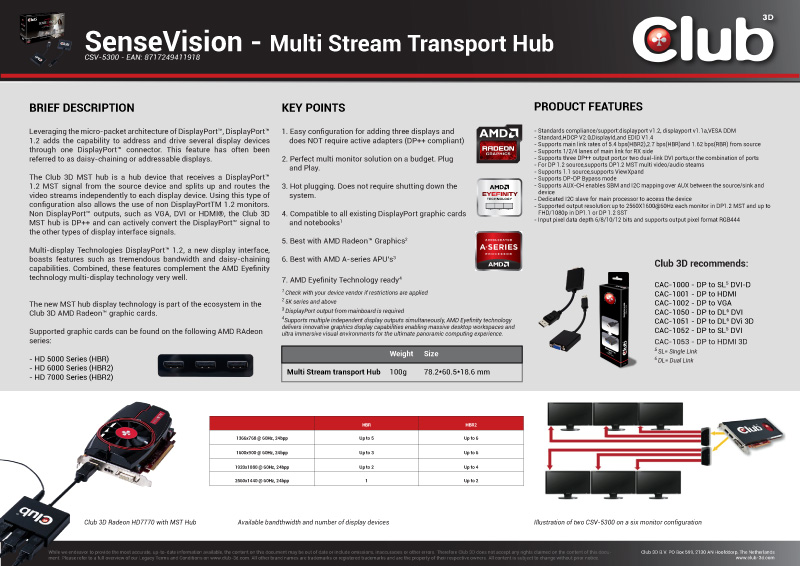 The Club 3D MST Hub will support 3x 1080p displays, or 2x 1440p displays. The hub also supports 10-bit color with supported cards and displays. HBR2 support on recent AMD cards provides enough bandwidth for 4x 1080p displays over DP1.2, and Club 3D has released a version to support that as well.
The Club 3D MST Hub will support 3x 1080p displays, or 2x 1440p displays. The hub also supports 10-bit color with supported cards and displays. HBR2 support on recent AMD cards provides enough bandwidth for 4x 1080p displays over DP1.2, and Club 3D has released a version to support that as well.
The Club 3D MST Hub supports DisplayPort 1.2 multi video and audio stremas. Paired with AMD Radeon R9 290 series and R7 260 series graphics cards, you can send True Audio streams to your monitors through the DisplayPort signal.
An HDMI version of the hub, the CSV-5300H, has three dedicated HDMI 1.4 outputs, and sends audio through those channels as well.
Detailed Specs:
- Standards compliance/support:displayport v1.2, displayport v1.1a,VESA DDM
- Standard,HDCP V2.0,DisplayId,and EDID V1.4
- Supports main link rates of 5.4 bps(HBR2),2.7 bps(HBR)and 1.62 bps(RBR) from source
- Supports 1/2/4 lanes of main link for RX side
- Supports three DP++ output port,or two dual-link DVI ports,or the combination of ports
- For DP 1.2 source,supports DP1.2 MST multi video/audio steams
- Supports 1.1 source,supports ViewXpand
- Supports DP-DP Bypass mode
- Supports AUX-CH enables SBM and I2C mapping over AUX between the source/sink and device
- Dedicated I2C slave for main processor to access the device
- Supported output resolution:up to 2560X1600@60Hz each monitor in DP1.2 MST and up to
- FHD/1080p in DP1.1 or DP 1.2 SST
- Input pixel data depth 6/8/10/12 bits and supports output pixel format RGB444
Compatibility Note - The MST Hub itself does not require a driver for basic functionality. However support from the GPU manufacturer is required to create an SLS (Single Large Surface) - AMD Eyefinity or NVIDIA Surround.
To date, only AMD offers SLS support (Eyefinity) on the Club 3D Support. NVIDIA GPUs can use the MST Hub to connect three individual monitors to one GPU connector, but NVIDIA Surround is not supported.
The Hardware & Design Questions
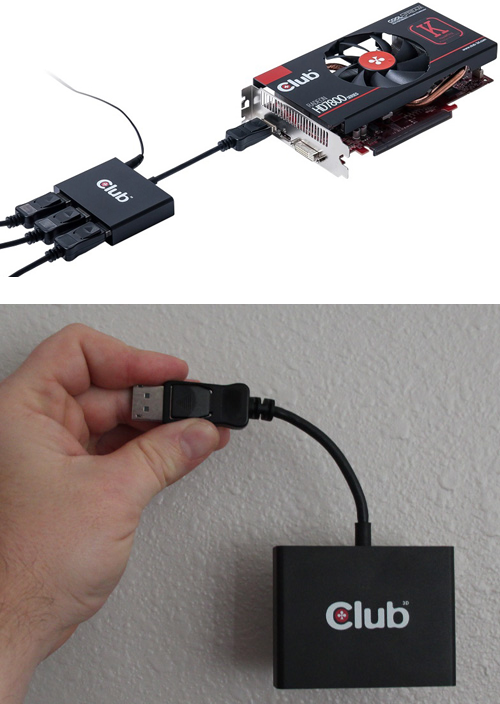 The Club 3D MST Hub is pretty unassuming. It has three female DisplayPort connectors, and a short pigtail DisplayPort connector for your GPU. It also requires a an external power brick, which is included.
The Club 3D MST Hub is pretty unassuming. It has three female DisplayPort connectors, and a short pigtail DisplayPort connector for your GPU. It also requires a an external power brick, which is included.
Two main points of contention on the design are around the power brick and the pigtail connector. Several users on the WSGF questioned the need for a power brick, and I questioned the decision on the connector.
Regarding the power brick, users wondered why the unit wasn't powered from the DisplayPort connector itself (like other signal splitters), or possibly a USB connection (like the Matrox TripleHead2Go). I reached out to Club3D on this issue, and their response was that the USB connection didn't provide enough current to power the signal for three displays. And an external power source helped with product stability. A recently released model, the CSV-5200, which splits into two DP 1.2 signals is USB powered.
My concern around the pigtail connector had to do with the short length. Given the need for cable management in multi-monitor solutions, I would have thought it better to have a single longer cable between the GPU and the MST Hub, rather than running three long cables from the displays to the MST Hub. A longer cable on the MST Hub would have allowed for short cables to be used at the monitors, and significantly reduced cable clutter.
I posed this question to Club 3D as well, and their response was that while they understood my concern and use case, they erred on the side of portability for laptop users. And while I understand this decision, I do think it still leads to some issues.
First, the connector on the end of the hub is a full sized DisplayPort connector. Most laptops have transitioned to Mini-DP, requiring the user to find and carry an adapter cable. I've personally had issues with adapter cables being flaky and causing signal issues.
Second, I worry about the strain on the pigtail while the unit is hanging from the back of my desktop chassis. If the stress leads to frayed wires internally, the unit is as good as dead.
I tried using a DisplayPort extension to solve this problem. Even though it seemed to be of high quality, it gave me issues with blanking screens and horizontal artifacts flashing across the screen. I validated it was the extension by using it on my single 21:9 panel as well.
For my money, I would have rather seen a female DisplayPort connector for the signal side - like we've historically seen on the Matrox products. Club 3D could have include short DP and mini-DP cables for it's laptop users. Desktop users will already have a long cable available.
Setup and Configuration
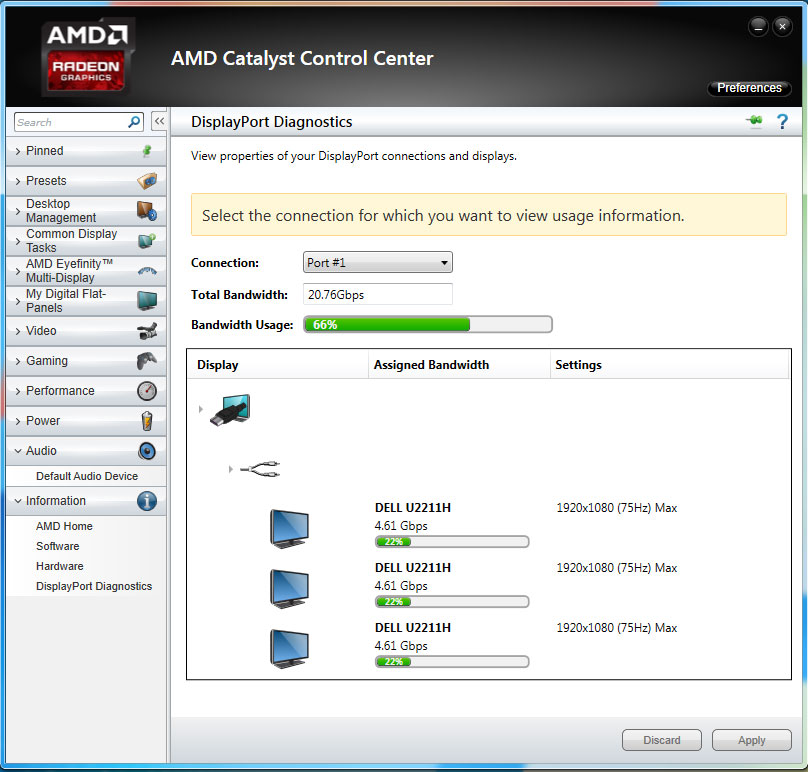 Physically the unit is a breeze to install. Connect the unit to your GPU, connect the power adapter, and then connect three monitors. The most difficult part was crawling under my desk to plug in the power brick.
Physically the unit is a breeze to install. Connect the unit to your GPU, connect the power adapter, and then connect three monitors. The most difficult part was crawling under my desk to plug in the power brick.
With regards to connecting three monitors, you can mix and match to your heart's content. And with the inclusion of the DisplayPort++ spec, you won't need active adapters. Simple passive cables will allow you to connect whatever you want.
I tried the unit using 3x DP>DP cables, simply using it to split the signal. I also used 3x DP>DVI cables, both splitting the signal and converting to DVI. And finally I tried a mix-and-match approach. I used 1x DP>DP, 1x DP>DVI and 1x DP>HDMI. All worked without a hitch. The AMD driver gives you a cool little window to show you which monitors are plugged in, and how much bandwidth is being used.
Though I didn't experience this issue, some users and reviewers have talked about issues with resolution detection. The issue was that native resolution would be seen on one or two monitors, but the third would only show at 640x480.
The consistent solution seems to be a full uninstall of the driver, and then a reinstall. Given that the MST Hub "driver" for Eyefinity is in the AMD driver itself, this makes some sense. Frustrating, but easily solved.
Usage & Experience
My initial experience was a little concerning, as I was having issues with screen blanking. This issue had been reported by members of the WSGF, and Club 3D responded with an updated EEPROM which fixed the issue. My unit already had the updated EEPROM, but I was still getting random and somewhat frequent blanking. A driver uninstall and reinstall fixed the issue.
I've used the Club 3D MST Hub for more than six months (this review is well overdue). The first couple of months were on my original test rig, which was a Win7 build. From time to time - rarely - I would still get a blank screen. It was always after the unit had gone to sleep, and was trying to wake up.
The fix here was to unplug the MST Hub from the GPU and replug it, with one or two instances requiring me to unplug the power brick as well. The simpler solution ended up just being to reboot the machine.
I asked Club 3D about this, and they informed me that a new version was being released to help address this rare issue. The newer version would have updated controller chips for improved performance, as well as a reset button reset button on the unit.
A couple of months in, I upgraded my test rig from an FX-8350 to an FX-9790. This resulted in a clean install of Win8, and a fresh GPU driver. Since then, I not had any issues. I'm not sure if it was something with the Win8 driver model, a fully clean system, or an updated Catalyst driver from AMD, but I've been issue free - and I've been torturing the thing.
My "test rig" is used solely for gaming, GPU testing and game testing. With the game testing (Detailed Report creation for the WSGF Games Database), I looking at single screen, 21:9, multi-monitor and 4k resolutions. I don't reboot the machine between different configurations. I simply hot-swap between monitors. Repeatedly.
The MST Hub hasn't thrown me any issues unplugging it, and plugging it back in over the course of analyzing a game. And Windows hasn't thrown up either. This is a much more torturous use case than most users would have, but it does bode well for people that would swap between multi-mon and 21:9 (or 4k), depending on game support.
Expanding the Product Line
As referenced earlier, Club 3D has been expanding the MST Hub product line since I received my initial review unit. The have released the CSV-5200 two port version, and an update to the CSV-5300 three port version. They have also released an HDMI version of the three port model, the CSV-5300H. And they have released a four port model, the CSV-5400.
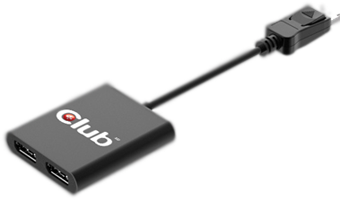
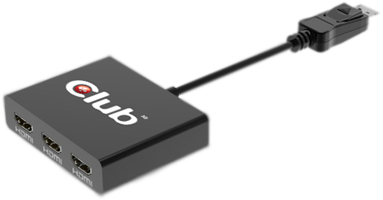

They have also just recently released a notebook docking station that marries an MST Hub with a USB 3.0 docking station. It connects to your laptop via 1x Mini-DP 1.2 and 1x USB 3.0. It outputs 2x Mini-DP 1.2, 3x USB 3.0 and 1x Ethernet.
Both DisplayPort outputs are HBR2, and the docking station can support up to eight displays when coupled with two CSV-5400 MST Hubs. As with the larger MST Hubs, it requires an external power adapter.
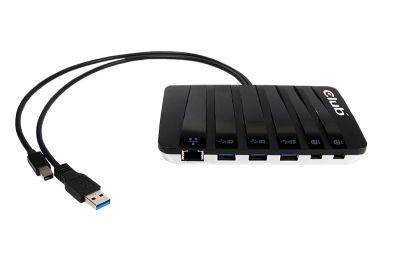
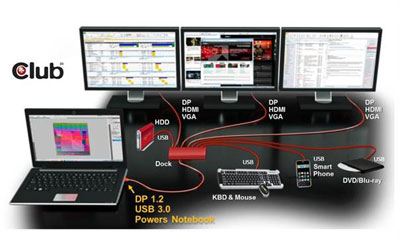
Conclusions
 As I said early in the review, the Club 3D MST Hub isn't something a desktop user is going to seek out unless you need it. About the only "convenience" (e.g., "want") it could satisfy is to simplify routine configuration changes between multi-monitor and single display configurations.
As I said early in the review, the Club 3D MST Hub isn't something a desktop user is going to seek out unless you need it. About the only "convenience" (e.g., "want") it could satisfy is to simplify routine configuration changes between multi-monitor and single display configurations.
The product could fill an actual need for laptop users who desire the increased productivity of multiple displays. In either case the product works well, and once successfully installed is basically hassle free.
Positives
- Works as expected
- Solves numerous problems
- Allows for Eyefinity5/6 on 3-port cards
- Unobtrusive
- Inexpensive
Neutral
- May require a clean Catalyst driver install. This is often the case with Catalyst driver updates, and thus I rate it "neutral".
- Isn't supported by NVIDIA for Surround. Will work as independent displays. The ball is in NVIDIA's court to update their display driver.
Negative
- Pigtail cable used for GPU connection.